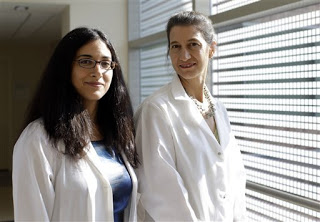Hospitals can learn from revealing account of the attack of a superbug; sequencing germ’s DNA seems to be key

A candid account of how a superbug was contained at one of
the nation’s leading research hospitals indicates that fast sequencing of a germ’s
full DNA can make all the difference.
Over a six-month period, Klebsiella pneumonia, or KPC, a germ that
cannot be treated by most antibiotics, sickened 18 people at the National Institutes of Health. Six of
them died and another five, though they survived the effects of the germ, died
from the disease that originally brought them to the facility.
cannot be treated by most antibiotics, sickened 18 people at the National Institutes of Health. Six of
them died and another five, though they survived the effects of the germ, died
from the disease that originally brought them to the facility.
Infections at health-care facilities kill about 100,000 Americans each year. But, fearful of lawsuits, hospitals generally
don’t reveal to the public when infections outfox control measures, reports
Lauran Neergaard for The Associated
Press. That changed this week when government researchers published the story of what happened at NIH.
don’t reveal to the public when infections outfox control measures, reports
Lauran Neergaard for The Associated
Press. That changed this week when government researchers published the story of what happened at NIH.
Dr. Julie Segre, a senior investigator at NIH’s National
Human Genome Research Institute, was in charge of the “genetic sleuthing that
found the bug hiding in sink drains and, most chilling, even in a ventilator
that had been cleaned with bleach,” Neergaard reports. A multidrug-resistant strain of Klepsiella bacteria has emerged that spreads easily
between patients who are very ill, and it kills half of whomever it sickens.
Human Genome Research Institute, was in charge of the “genetic sleuthing that
found the bug hiding in sink drains and, most chilling, even in a ventilator
that had been cleaned with bleach,” Neergaard reports. A multidrug-resistant strain of Klepsiella bacteria has emerged that spreads easily
between patients who are very ill, and it kills half of whomever it sickens.
On June 13, 2011, a research nurse checked the medical
records of a study participant who was being transferred from a New York City
hospital and was critically ill with a rare lung disease. She found the patient
had KPC, prompting the hospital to put her in strict isolation. “Everyone
entering her room donned a protective gown and gloves and rigorously washed
their hands,” Neergaard reports. “Her medical equipment got special
decontamination. All other patients in the intensive care unit had their throats and groins
tested regularly to see if the bug was spreading.” All seemed to be clear and
the woman was sent home two days later.
records of a study participant who was being transferred from a New York City
hospital and was critically ill with a rare lung disease. She found the patient
had KPC, prompting the hospital to put her in strict isolation. “Everyone
entering her room donned a protective gown and gloves and rigorously washed
their hands,” Neergaard reports. “Her medical equipment got special
decontamination. All other patients in the intensive care unit had their throats and groins
tested regularly to see if the bug was spreading.” All seemed to be clear and
the woman was sent home two days later.
But three weeks later, a patient with cancer was found to
have KPC, though he was never in the presence of the first patient. Ten
days later, a woman with an immune disease also got sick with KPC. Both died from
the infection.
have KPC, though he was never in the presence of the first patient. Ten
days later, a woman with an immune disease also got sick with KPC. Both died from
the infection.
Researchers wondered if the cases were related or if the
patients were arriving already infected with KPC. Segre turned to DNA for answers. “As
bacteria multiply, mistakes appear and are repaired in their genetic codes,” Neergaard reports. “Sequencing that genome allowed Segre to follow differences
in single genetic letters like a trail of the germ’s transmission and
evolution.” Using this method, Segre discovered the KPC appearing at NIH was
the same strain that came from the New York patient. “Testing bacteria from the
17 additional patients who ultimately caught it shows the KPC was transmitted
three separate times from Patient No. 1 and then spread more widely,” Neergaard
reports.
patients were arriving already infected with KPC. Segre turned to DNA for answers. “As
bacteria multiply, mistakes appear and are repaired in their genetic codes,” Neergaard reports. “Sequencing that genome allowed Segre to follow differences
in single genetic letters like a trail of the germ’s transmission and
evolution.” Using this method, Segre discovered the KPC appearing at NIH was
the same strain that came from the New York patient. “Testing bacteria from the
17 additional patients who ultimately caught it shows the KPC was transmitted
three separate times from Patient No. 1 and then spread more widely,” Neergaard
reports.
NIH completely overhauled its decontamination practices,
but the bacteria continued to spread. By November, the bacteria appeared in two patients who were not even in intensive care. Finally, the hospital built a new
isolation room and all 200-plus patients in the hospital were subject to rectal
testing.
but the bacteria continued to spread. By November, the bacteria appeared in two patients who were not even in intensive care. Finally, the hospital built a new
isolation room and all 200-plus patients in the hospital were subject to rectal
testing.
The contamination is now contained, but the account of it is giving pause to infection-control specialists around the country.
“Absolutely this could happen in any hospital,” said Dr. Deverick Anderson,
co-director of a Duke University
infection control network. (Read more)
“Absolutely this could happen in any hospital,” said Dr. Deverick Anderson,
co-director of a Duke University
infection control network. (Read more)
